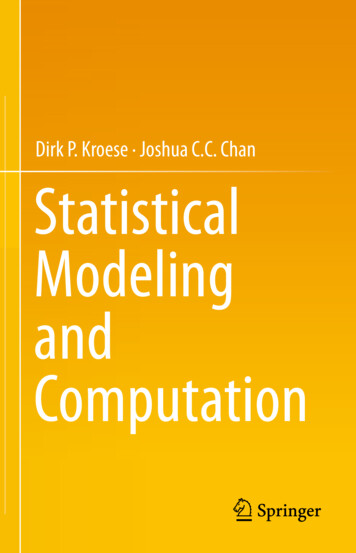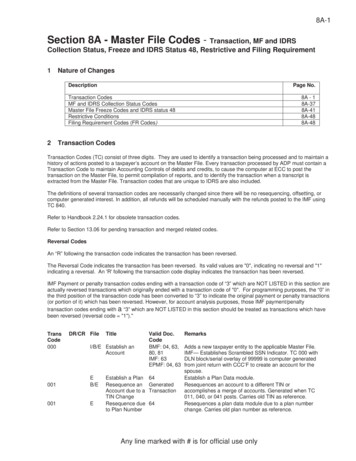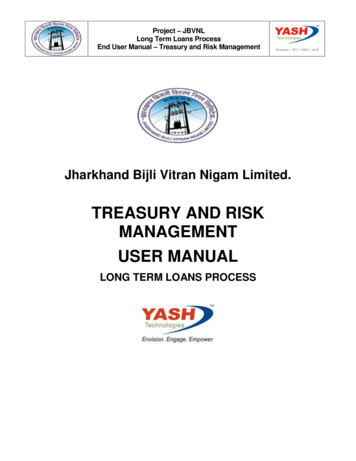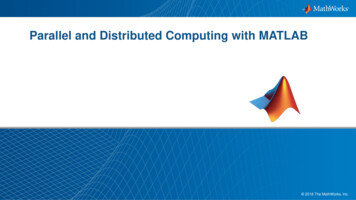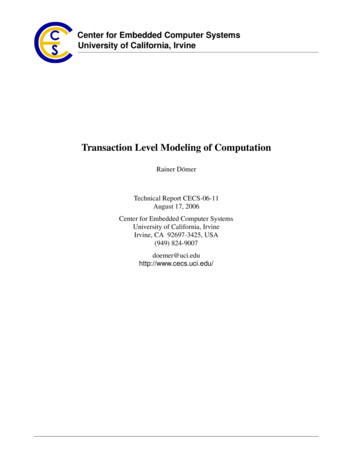
Transcription
Center for Embedded Computer SystemsUniversity of California, IrvineTransaction Level Modeling of ComputationRainer DömerTechnical Report CECS-06-11August 17, 2006Center for Embedded Computer SystemsUniversity of California, IrvineIrvine, CA 92697-3425, USA(949) 824-9007doemer@uci.eduhttp://www.cecs.uci.edu/
Transaction Level Modeling of ComputationRainer DömerTechnical Report CECS-06-11August 17, 2006Center for Embedded Computer SystemsUniversity of California, IrvineIrvine, CA 92697-3425, USA(949) actThe design of embedded computing systems faces great challenges due to the huge complexity of these systems. The design complexity grows exponentially with the increasing number of components that have to cooperate properly. One solution to address the complexity problem is the modeling at higher levels of abstraction.However, it is generally not clear which features to abstract (and to what extend), nor how to use the remainingfeatures to create an executable model that allows meaningful, efficient and accurate analysis of the intendedsystem.Transaction Level Modeling (TLM) is widely accepted as an efficient technique for abstract modeling ofcommunication. TLM offers gains in simulation speed of up to four orders of magnitude, usually however, at theprice of low accuracy. So far, TLM as been used exclusively for communication.In this work, we propose to apply the concepts of TLM to computation. While the two aspects of embeddedsystem models, computation and communication, are different in nature, both share the same concepts, namelyfunctionality and timing. Thus, TLM, which is based on the separation of functionality and timing, is equallyapplicable to both, communication and computation. In turn, the tremendous advantages of TLM can be utilizedas well for the abstract modeling of computation.While traditional work largely has focused on refinement and synthesis tasks, this work addresses the modeling of systems towards efficient accurate estimation and rapid design space exploration. The results of this workwill be directly applicable to established design flows in the industry.
Contents1 Introduction1.1 Motivation . . . . . . . . . . . . . . . . . .1.2 Abstract Modeling . . . . . . . . . . . . .1.2.1 Is modeling an art? . . . . . . . . .1.2.2 What features should be abstracted?1.2.3 Architecture analogy . . . . . . . .1.3 Outline . . . . . . . . . . . . . . . . . . .12223332 Background2.1 Separation of Concerns . . . . . . . . . . . . . .2.1.1 Computation and communication . . . .2.1.2 Orthogonality of concepts . . . . . . . .2.2 Transaction Level Modeling of Communication .2.2.1 TLM trade-off . . . . . . . . . . . . . .2.2.2 Systematic analysis . . . . . . . . . . . .2.2.3 Modeling approach . . . . . . . . . . . .2.2.4 Analysis metrics and measurement setup2.2.5 Results . . . . . . . . . . . . . . . . . .2.2.6 Generalization . . . . . . . . . . . . . .2.3 Computer-Aided Re-coding . . . . . . . . . . . .2.3.1 Coding bottleneck . . . . . . . . . . . .2.3.2 Re-coding approach . . . . . . . . . . .2.3.3 Interactive source re-coder . . . . . . . .2.3.4 Productivity gains . . . . . . . . . . . .2.4 Communication Synthesis . . . . . . . . . . . .2.4.1 Layer-based approach . . . . . . . . . .2.4.2 Automatic model generation . . . . . . .2.5 Other Related Work . . . . . . . . . . . . . . . .2.5.1 TLM of communication . . . . . . . . .2.5.2 Communication synthesis . . . . . . . .2.5.3 Computation abstraction . . . . . . . . 15163 Transaction Level Modeling of Computation3.1 Separation of Functionality and Timing .3.2 Granularity of Timing . . . . . . . . . . .3.3 Computation Abstraction . . . . . . . . .3.4 Result-Oriented Modeling . . . . . . . .3.4.1 ROM approach . . . . . . . . . .3.4.2 Airplane arrival analogy . . . . .3.4.3 ROM of computation . . . . . . .3.4.4 Initial Experiments . . . . . . . .3.4.5 Initial Results . . . . . . . . . . .4 Current Status and Future Work.17i
5 Summary and Conclusion18References18ii
Transaction Level Modeling of ComputationRainer DömerCenter for Embedded Computer SystemsUniversity of California, IrvineIrvine, CA 92697-3425, tion and rapid design space exploration. The results of this work will be directly applicable to established design flows in the industry.The design of embedded computing systems facesgreat challenges due to the huge complexity of thesesystems. The design complexity grows exponentiallywith the increasing number of components that haveto cooperate properly. One solution to address thecomplexity problem is the modeling at higher levels ofabstraction. However, it is generally not clear whichfeatures to abstract (and to what extend), nor howto use the remaining features to create an executablemodel that allows meaningful, efficient and accurateanalysis of the intended system.Transaction Level Modeling (TLM) is widely accepted as an efficient technique for abstract modeling of communication. TLM offers gains in simulation speed of up to four orders of magnitude, usuallyhowever, at the price of low accuracy. So far, TLM asbeen used exclusively for communication.In this work, we propose to apply the concepts ofTLM to computation. While the two aspects of embedded system models, computation and communication,are different in nature, both share the same concepts,namely functionality and timing. Thus, TLM, which isbased on the separation of functionality and timing, isequally applicable to both, communication and computation. In turn, the tremendous advantages of TLMcan be utilized as well for the abstract modeling ofcomputation.While traditional work largely has focused on refinement and synthesis tasks, this work addresses themodeling of systems towards efficient accurate esti-1 IntroductionAs we enter the information era, embedded computing systems have a profound impact on our everydaylife and our entire society. With applications ranging from smart home appliances to video-enabled mobile phones, from real-time automotive applicationsto communication satellites, and from portable multimedia components to reliable medical devices, we interact and depend on embedded systems on a dailybasis.While embedded systems typically do not look likecomputers due to their hidden integration into largerproducts, they contain similar hardware and softwarecomponents regular computers are made of. Moreover, embedded systems are special-purpose devices,dedicated to one predefined application and face stringent constraints including high reliability, low power,hard real-time, and low cost.Over recent years, embedded systems have gaineda tremendous amount of functionality and processingpower, and at the same time, can now be integratedinto a single System-on-Chip (SoC). The design ofsuch systems, however, faces great challenges due tothe huge complexity of these systems. The systemcomplexity grows rapidly with the increasing numberof components that have to cooperate properly. In ad1
well-designed model will accurately represent and define the properties of the end product, while allowingefficient handling and fast examination.Moreover, most embedded system models are executable. Execution of the model allows to simulate thebehavior of the intended system and to measure properties beyond the immediate ones in the model description. For example, simulation enables the prediction of properties such as performance and throughput.The choice of the proper abstraction level is critical. Ideally, multiple well-defined abstraction levels are needed to enable gradual system refinementand synthesis, adding more detail to the design modelwith every step. In other words, a perfect model retains only the essential properties needed for the job athand, and abstracts away all unneeded features. Then,as the design process continues, incrementally morefeatures are added to the model, reflecting the designdecisions taken.The main objective of this work is to improvethe modeling of embedded systems, in particular themodeling of computation (as discussed later in Section 3). The goal of a ”good” model is, with minimummodeling effort, to allow fast and accurate predictionof critical properties of the described system.To achieve these goals, well-defined metrics andmeasurement setups need to be defined. Then, a systematic analysis of actual system models is necessary,so that essential properties and proper abstraction levels can be identified and efficient modeling techniquesand guidelines can be developed.dition, expectations grow while constraints are tightened. Last but not least, customer demand constantlyrequires a shorter time-to-market and thus puts highpressure on designers to reduce the design time forembedded systems.1.1MotivationThe international Semiconductor Industry Association ITRS, in its design roadmap [67], predicts a significant productivity gap and anticipates tremendouschallenges for the semiconductor industry in the nearfuture. The 2004 update of the roadmap identifiessystem-level design as a major challenge to advancethe design process. System complexity is listed as thetop-most challenge in system-level design. As firstpromising solution to tackle the design complexity,the ITRS lists higher-level abstraction and specification. In other words, the most relevant driver to address the system complexity challenge is system-onchip design using specification at higher levels of abstraction.Higher-level of abstraction is in the ITRS report[67] also listed as a key long-term challenge for design verification. As simulation and synthesis, verification will have to keep up with the move to higherabstraction levels. In other words, system modelsmust be properly abstracted with the intended designtasks in mind, including verification and synthesis.1.2Abstract ModelingIn system level design, the importance of abstract specification and modeling cannot be overemphasized. Proper abstraction and modeling is thekey to efficient and accurate estimation and successfuldesign space exploration. However, in contrast to thegreat significance of abstraction and modeling, mostresearch has focused on tasks after the design specification phase such as simulation and synthesis. Littlehas been done to actually address the modeling problem, likely because this problem is not well-definedyet, and the quality of a model is not straightforwardto measure and compare.A model is an abstraction of reality. More specifically, an embedded system model is an abstract representation of an actual or intended system. Only a1.2.1Is modeling an art?Sometimes, people think that modeling is an art or atask that requires artistic talents in the model designer.This may be true for creating a painting or designinga sculpture, but does not hold for modeling of embedded systems. The quality of a piece of art cannot beobjectively determined, but the quality of an embedded system model can be quantitatively measured andcompared.To measure the properties of a model (and the properties of the modeled system), metrics, measurementsetups, and test environments are necessary. However, these can be clearly defined (as shown later in2
1.2.3Section 2.2.4, for example) and used to examine themodel. Thus, embedded system modeling is not anart, it is a technical task based on scientific principlesand concepts. Further, embedded system modelingcan be learned simply by following technical modeling guidelines, the creation of which is one objectiveof this work.Architecture analogyThe architectural blueprints of a house can serve as agood analogy of well-abstracted modeling. An architect, charged with designing a new building, typicallydevelops a set of models of her/his intended design inorder to examine, document and exhibit the intendedbuilding features, the general floorplan, room sizes,etc. For example, to exhibit the aesthetic qualitiesof the design, the architect often builds an abstractpaper model of the building that shows the threedimensional design in small scale. For the actualbuilding phase, however, a different model is needed.Here, the architect draws two-dimensional schematicblueprints for each floor which accurately show thelocation and dimensions of the walls, doors and windows, as well as water and gas pipes, etc.In this analogy, the purpose of the abstract modelsis clear, as is the inclusion or omission of design features. Different models serve different purposes andtherefore exhibit different properties. Important aspects are included and emphasized, and aspects of nointerest are abstracted away.Concluding the overview, the contribution of thiswork will be a systematic approach to abstraction andmodeling of computation in embedded systems.1.2.2 What features should be abstracted?It has been stated before that proper abstraction isthe key to successful modeling of embedded systems.However, it is generally not obvious which featuresin a model are needed, and which can be abstractedaway (and to what extend). Neither is it clear how tomodel the essential features in order to create an efficient executable model suitable for fast and accurateprediction and rapid design space exploration. Thisproblem is aggravated by the fact that most desiredfeatures typically pose a trade-off, or are even contradictory (e.g. high simulation speed and detailed functionality).It is the goal of this work to identify and includeonly desired features in models for common designscenarios (and to leave unneeded features out). Thus,we aim to identify minimal feature sets for effectivemodels, and also develop modeling guidelines thatmaximize the value of a model such that it provideshigh simulation speed, accurate functionality and/orprecise timing.Careful measurements and systematic analysis willbe necessary to identify and effectively navigate thetrade-offs involved. For this work, we will focus onperformance and accuracy metrics, and measure theseproperties using industry-standard applications suchas MP3 codecs and video processing algorithms.For most embedded applications, accurate timingand correct functionality are ”must-have” featuresin a model. Other important aspects include structural composition (such as the number and types ofprocessing elements) and estimated power consumption (e.g. for battery-powered mobile devices). Onthe other hand, implementation details, such as pins,waveforms and interrupts, are abstracted away inspecification models as these restrict the implementation, limit the design space, and unnecessarily increase the model complexity.1.3OutlineThe remainder of this document further details thiswork. Section 2 discusses background material in order to appropriately position this work with respect toealier and related work. Section 3 presents the mainidea of modeling computation using TLM and outlines the technical approach to be taken. Then, Section 4 discusses the current status of this approach andoutlines future work. Finally, Section 5 summarizesthis document and concludes with the expected impact of this work.2 BackgroundThe following sections present an executive summaryof four research tasks addressed by the author thatbuild the background for TLM of computation, in thecontext of other related work.3
2.1P1Separation of ConcernsP2v1One of the fundamental principles in embedded system modeling is the clear separation of concerns.Addressing separate issues independently from eachother very often leads to clear advantages over approaches where different aspects are intermixed. Inparticular, this applies to the design of system-leveldescription languages (SLDL).An excellent example of the separation of concerns is the SpecC [28, 31] approach defined in 1997[82]. The SpecC language and methodology created a world-wide impact in industry and academiaso that leading companies started the internationalSpecC Technology Open Consortium (STOC) [73] in1999.The SpecC language is based upon the clear separation of computation and communication, as well ason an orthogonal structure, which we will both brieflyreview in the following two sections.v2v3(a) MixedB1C1B2v1v2v3(b) ChannelB1v1B2v2v3(c) InlinedFigure 1: Separation of computation and communication.2.1.1 Computation and communicationiors and the communication is contained in the channel.For the implementation of a channel, its functionsare inlined into the connected behaviors and the encapsulated communication signals are exposed. Thisis illustrated in Figure 1(c). The channel has disappeared, the contained signals are exposed, and thecommunication protocol has been inlined into the behaviors. Note that in this final implementation model,communication and computation are no longer separated. The model again resembles the traditional HDLmodel, ready for implementation.In summary, modern SLDLs clearly separate communication from computation such that both can beeasily replaced if necessary (”plug-and-play”).It should be emphasized that this separation ofconcerns, which originated in SpecC, has also beenadopted in the SystemC [36] SLDL, version 2.0, in2000 [54]. Today, SystemC is the de-facto industrystandard SLDL, supported by the Open SystemC Initiative [56]. Finally, it should be mentioned that thesignificance of the separation of concerns has laterbeen emphasized as well in the Metropolis project atUC Berkeley [6].Clear separation of computation and communicationis an essential feature of any good system model asit enables ”plug-and-play”. This feature also distinguishes modern SLDLs from traditional hardware description languages (HDL) such as VHDL [39] andVerilog [40].A typical model of two communicating processesdescribed in a HDL is shown in Figure 1(a). Here it isimportant to note that there are two distinct portionsof code in the blocks, containing computation andcommunication (shaded), which are intermixed. Insuch a model, there is no way to automatically distinguish the code for communication from the code usedfor computation, because the purpose of the statements cannot be identified. Neither is it possible toautomatically exchange the communication protocol,nor to switch to a new algorithm to perform the computation.In order to allow automatic replacement of communication protocols and computation algorithms, separation of communication and computation is needed.This is supported in form of behaviors and channelsin the SpecC language [27], as shown in Figure 1(b).Here, the computation is encapsulated in the behav4
2.2.12.1.2 Orthogonality of conceptsAccurate communication modeling is an important issue for the design of embedded systems. However,efficient system level design requires also high execution performance.A second significant principle in system-level designis the orthogonality of concepts. Again, SpecC is agood example as it is based on the paradigm of providing orthogonal constructs for orthogonal concepts.Before designing the SpecC language, the authorsidentified the essential concepts required for systemlevel design, including concurrency, hierarchy, communication, synchronization, exception handling, andtiming [28]. Since in principle these concepts are independent of each other, i.e. orthogonal, the SpecClanguage was designed to provide exactly one independent syntactical construct for each concept. As aresult, the SpecC language largely1 is orthogonal inits basic constructs. This is extremly beneficial forCAD applications as this significantly simplifies thedevelopment of the tools working with the language.AccuracyA c c u r a teIn a c c u ra teLowPerformance Hig hFigure 2: Transaction Level Modeling Trade-Off.In contrast, VHDL [39] can serve as a counter example. In VHDL, signals incorporate synchronization, data storage and timing. Without additional annotations or coding conventions, this makes it hard toidentify for which purpose a particular signal is actually used, and thus an efficient implementation isaggravated.2.2TLM trade-offFor efficient communication modeling, TransactionLevel Modeling (TLM) has been proposed [36]. TLMabstracts the communication in a system to wholetransactions, abstracting away low level details aboutpins, wires and waveforms [17]. This results in models that execute dramatically faster than synthesizable, bit-accurate models. This benefit, however, usually comes at the price of low accuracy.In general, TLMs pose a trade-off between an improvement in simulation speed and a loss in accuracy,as illustrated in Figure 2. The trade-off essentiallyallows models at different degrees of accuracy andspeed. However, having both high speed and highaccuracy at the same time is typically not possible.High simulation speed is traded in for low accuracy,and a high degree of accuracy comes at the price oflow speed. Models with this trade-off fall into thegray area of the diagram. Models in the dark area areobviously existent, but practically unusable, whereasmodels in the white area are highly desirable but typically not achievable.Transaction Level Modeling of CommunicationOur previous work, Transaction Level Modeling forCommunication [65], can be seen as the counterpartof the work described in this document. The formerhas been applied to the communication, the latter willbe applied to the computation aspects of embeddedsystems. As we have seen in Section 2.1.1, embedded system models consist of exactly these two parts,computation and communication. Thus, the combination of the former and this work will solve the wholemodeling problem.2.2.2Systematic analysisAlthough TLM has been generally accepted as onesolution to tackle SoC design complexity, the TLMtrade-off however, has not been examined in detail.Our aim is to systematically study and analyze the1This author later realized that the goal of orthogonality hasnot been completely reached in SpecC. Behavioral and structuralhierarchy are not entirely independently implemented from concurrency.5
Transaction Level Model (TLM) The TLM is themost abstract model; it handles user data at theuser transaction granularity and transfers data regardless of its size using a single memcpy andsimulates timing by a single wait-for-time statement. Instead of modeling the bus arbitration, itresolves concurrent access using a semaphore.TLM trade-off quantitatively. More specifically, wequantify the performance gains of TLM and measurethe loss in accuracy for a wide range of bus systems.As a first step, we define our approach to TLM asbased on the granularity of data and arbitration handling. We then define proper metrics and test setupsfor measuring the performance improvement and theaccuracy loss. We apply our TLM abstraction approach to examples of different bus categories andcreate models at different abstraction levels, in particular two classes of TLMs (ATLM and TLM), andcompare them against a fully accurate Bus FunctionalModel (BFM) as a reference.Arbitrated TLM (ATLM) The ATLM simulates thebus access with bus transaction granularity (e.g.AHB bus primitives), at the protocol layer level.The ATLM accurately models the bus arbitrationfor each bus transaction.Bus Functional Model (BFM) The BFM is a synthesizable, bus cycle-accurate and pin-accuratebus model. It implements all layers down to thephysical layer, covering all timing and functionalproperties of the bus. It handles arbitration perbus transaction and has the capability to take arbitration decisions on a bus cycle granularity.2.2.3 Modeling approachTLM allows a wide variety of modeling styles andabstractions [17]. For our modeling, we focus onthe granularity of data and arbitration handling. Wedefine three classes of granularity applicable to anybus protocol, and match these granularity classes tothree model types. Figure 3 shows the granularitylevels with respect to time and indicates the correlation to models and layers. A user transaction is themost coarse grain element of transferring a contiguous block of bytes with arbitrary length. It is splitinto bus transactions, which are bus transfer primitives, such as a word transfer. Each bus transaction isusually processed in several bus cycles, which represent the finest granularity in our modeling.D at a G ran u l ari t yU s er T r a n s a c tio nM A CA T L MB u s T r a n s a c tio nP r o to c o lB F MB u s C y c leP h y s ic a lAnalysis metrics and measurement setupWe focus on two aspects for the analysis: the simulation performance, since a performance gain is themain premise of TLM, and the timing accuracy, asa loss is expected with abstraction. Our metric forthe performance is the simulation bandwidth. We define bandwidth as the amount of data transferred inthe simulation per second of real-time, using a minimal scenario with a single master and a single slave.One aspect of model accuracy is the timing accuracyfor each transmitted user transaction. As one metric,we utilize the transfer duration per user transactionand define the duration error as the percentage errorover the bus standard, so that a timing accurate modelexhibits 0% error:LayerM o d elT L M2.2.4timeFigure 3: Model classes and their granularity.Our classes of granularity correlate with the layersdefined in the ISO OSI reference model [41]: the media access control (MAC), the protocol sublayer, andthe physical layer. Each layer handles data and arbitration at its own granularity. According to our classesof granularity, we consider models at three differentabstraction levels.dstd :duration as per standarddtest :duration in model under test dtest dstd 100 dstderrori(1)Since the actual experienced timing accuracyhighly depends on the application and architecturespecifics, we define a generic test setup and a procedure that covers a range of applications. The designer6
S la v e # 1L o wP r io r it yM a s te rS la v e # 21000Simulated Bandwidth [MByte/sec]HighP r io r it yM a s te rBus ModelFigure 4: Dual master setup for accuracy measurements.can then derive the expected accuracy for her/his particular setup.In a generic test setup with two masters and twoslaves connected to the same bus (Figure 4), eachmaster transfers a predefined set of user transactions.The transactions vary linear randomly in the base address, size, and the delay to the next transaction (simulating the application’s computation). We record thetiming information of each individual transaction forlater analysis. We repeat the analysis over differentlevels of bus contention, which allows to infer the accuracy over a range of applications.TLMATLM (b)ATLM (a)BFM1001010.10.010.001110100Transaction Size [bytes]1000Figure 5: Performance for the AMBA AHB models.tion bandwidth is independent of the transaction size,since a constant number of operations is executed foreach transfer. The ATLMs are two orders of magnitude slower due to the finer granularity of modelingindividual bus transactions. Starting with the ATLMs,the graphs exhibit a saw tooth shape due to the nonlinear split of user transactions into bus transactions(e.g. 3 bytes are transferred in 2 bus transactions:byte short, whereas 4 bytes are transferred in 1 bustransaction: a word). The BFM is again two ordersof magnitude slower than the ATLMs due to the finegrain modeling of individual wires and additional active components (e.g. multiplexers).2.2.5 ResultsWe have applied our granularity-based abstraction tothree common bus systems covering diverse communication protocols. We have chosen the AHB ofAMBA [3], as a representative of parallel on-chip bussystems with centralized industry-accepted standardfor on-chip bus systems. For the second categoryof off-chip serial busses with distributed arbitration,we have selected the Controller Area Network (CAN)[11]. This bus system dominates in automotive applications. Third, we analyze the category of customprocessor-specific busses that are typically much simpler than the general purpose standard busses. Here,we have chosen the Motorola ColdFire Master Bus[53] that is used by the popular ColdFire MCF5206processor. We have modeled, validated, and systematically analyzed each bus using our performance andaccuracy metrics.Figure 5 shows the performance results for one example, the AMBA AHB. It confirms the TLM expectations: the simulation speed increases significantlywith abstraction. The performance raises with eachTLM abstraction by two orders of magnitude. As expected, the TLM executes the fastest. The simula-On the other hand, the accuracy significantly degrades with abstraction. One example, again from theAMBA AHB, is shown in Figure 6. The x-axis denotes the amount of bus contention in percent, eachmeasurement point for a model reflects the average error over the analyzed 5000 user transactions. The actual accuracy depends strongly on the bus contentionin the measurement scenario. Under the absence ofbus contention, all models are accurate. For the abstract models ATLM and TLM, the timing error increases with a r
The design of embedded computing systems faces great challenges due to the huge complexity of these sys-tems. The design complexity grows exponentially with the increasing number of components that have to coop-erate properly. One solution to address the complexity


